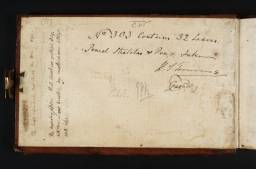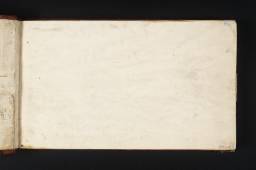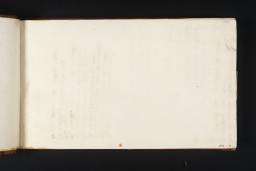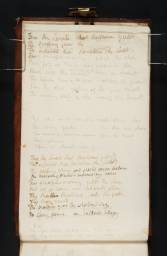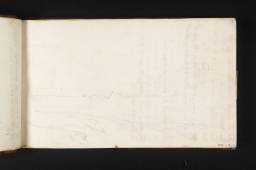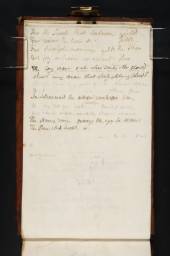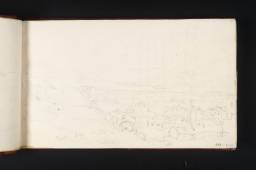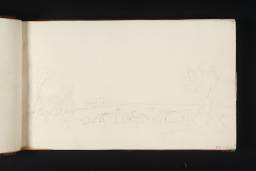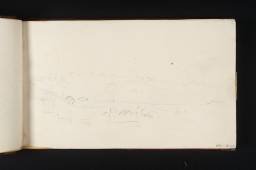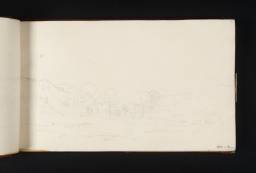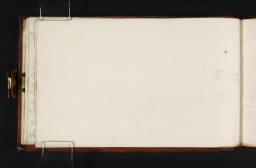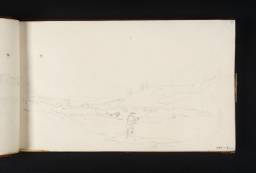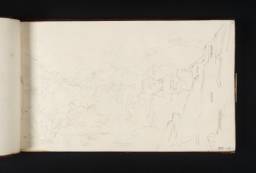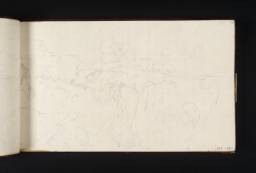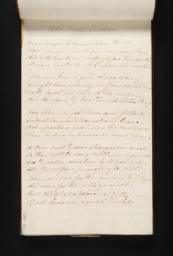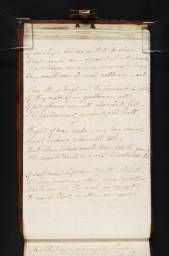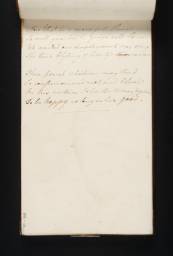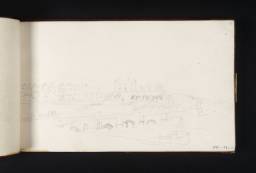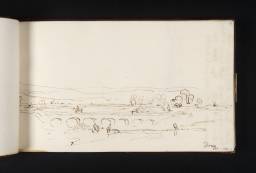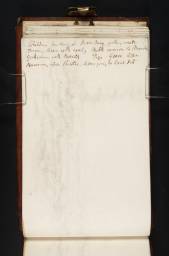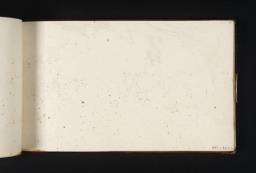Turner Bequest CVI
Sketchbook, bound in calf, with one brass clasp
88 leaves of white wove paper and four leaves of modern white paper
Approximate page size 108 x 185mm
Original paper watermarked ‘J. WHATMAN 1805’
Made by William Balston and Finch and Thomas Robert Hollingworth at Turkey Mill, Maidstone, Kent
Endorsed by the Executors of the Turner Bequest in ink ‘No 303 Contains 32 Leaves. | Pencil sketches Pen and Ink’ and signed by Henry Scott Trimmer and Charles Turner in ink ‘H.S. Trimmer’ and ‘C. Turner’ and in pencil by Charles Lock Eastlake and John Prescott Knight ‘C.L.E.’ and ‘JPK’
John Ruskin’s endorsement is recorded by Finberg: ‘303. Lowland – England’ and ‘303. Some interesting sheets of M.S. one or two mere traces of pencil left, the rest cut out’.
88 leaves of white wove paper and four leaves of modern white paper
Approximate page size 108 x 185mm
Original paper watermarked ‘J. WHATMAN 1805’
Made by William Balston and Finch and Thomas Robert Hollingworth at Turkey Mill, Maidstone, Kent
Endorsed by the Executors of the Turner Bequest in ink ‘No 303 Contains 32 Leaves. | Pencil sketches Pen and Ink’ and signed by Henry Scott Trimmer and Charles Turner in ink ‘H.S. Trimmer’ and ‘C. Turner’ and in pencil by Charles Lock Eastlake and John Prescott Knight ‘C.L.E.’ and ‘JPK’
John Ruskin’s endorsement is recorded by Finberg: ‘303. Lowland – England’ and ‘303. Some interesting sheets of M.S. one or two mere traces of pencil left, the rest cut out’.
Accepted by the nation as part of the Turner Bequest 1856
Exhibition history
References
This sketchbook contains verse, other notes and various landscape subjects, not all currently identified. Those that are belong to Yorkshire (Harewood) and the Midlands (Burton-on-Trent) while others probably represent Dovedale. Finberg dated the book 1807–9 but in this catalogue it is given to 1808, on the basis that the subjects best correspond to aspects of Turner’s summer tour that year 1808, the Midlands and Dovedale subjects being drawn on his way to Knutsford and Tabley, Cheshire to stay with Sir John Leicester and those of Harewood coming from later in the tour when he stayed with Walter Fawkes at Farnley Hall. Arithmetic inside the back cover (D07254) seems to note payments in March, July and September ‘8’. However, for the contents as a whole this dating should be regarded as provisional. This catalogue proposes that Turner was also in Yorkshire in 1809,1 and he was certainly back in 1810. Moreover, we cannot be sure of the order in which the drawings in this or indeed the other 1808 sketchbooks were made, and the range of territory covered in them together with the number of still-unidentified subjects argue for caution in this case.
Wilkinson says the book ‘matches the Tabley notebooks’ from 18082 but the binding and paper are different. In his opinion it ‘was probably kept as a poetry-jotting book, taken from place to place’, which might imply that drawings were added to it fairly haphazardly. Of a description of various activities written on folio 15 verso (D07151), Wilkinson suggests that ‘Milk carriers to Manchester’ indicates the Cheshire bank of the River Mersey. In fact, although the immediately facing drawing on folio 16 (D07152) of barges and carts at low water is unidentified topographically, 15 recto (D07150) depicts the Dove Aqueduct and the Trent and Mersey Canal near Egginton while Burton-on-Trent appears on folio 14 (D07149), as identified by Eric Shanes. Also due to Shanes is the recognition of folio 81 verso (D07233; Turner Bequest CVI 78a) as Viator’s Bridge, Dovedale, indicating that Turner continued into the most picturesque reaches of Dovedale – highly likely for scenic reasons but also for the attractions of fishing, always a consideration on his summer tours, and logical if he were moving from the Midlands north-west towards Knutsford. Possibly some of the unidentified sketches of river scenery or fishing in the book represent the River Dove.
Viator’s Bridge is drawn in pen with the same grace and fluency as a large house or castle on a ridge between trees, nearby on folio 85 verso (D07241; Turner Bequest CVI 82a). Technically, these views seem to form a pair whose scenic qualities have moved Turner to treat them in the same way. Perhaps their subjects were not far apart. For the latter, Shanes suggests Belvoir Castle, Leicestershire, which Turner may have passed earlier on his journey from London, but it could also be Haddon Hall seen from near Dovedale. One other sketch, that of the Dove Aqueduct already mentioned, is in ink outline; all others are in pencil, including the cluster of views of Harewood Castle and bridge towards the back of the book (for example folio 88 verso, D07246; Turner Bequest CVI 85a).
The poetry in the book is varied in theme and inspiration. Folios 2 verso, 3 verso, 34 verso–36 verso and 68 verso (D07134, D07136, D07171–D07175, D07209; Turner Bequest CVI 65a) have versions of a poem beginning ‘Few the sweets that Autumn yields’, also drafted in the Greenwich sketchbook (Tate D06725; Turner Bequest CII 3). Turner is probably recalling James Thomson’s The Seasons. Lines to ‘Silver Thames’ inside the back cover (D40627) are also reprised, more elegantly, in Greenwich (D06725 again). The poem ‘John Bull Content’ on folios 11–12 (D07145–D07147) is recognisably a pastiche or imitation of the longer ‘Song’ by an unidentified author that had appeared with ‘Select Modern Poetry’ in The Gentleman’s Magazine, February 1805 (p.158); it might further be associated with the play John Bull by George Colman the younger, 1803, or with lines sometimes attributed to the poet William Cowper but not acknowledged by him.
Already preparing himself for his lectures as Professor of Perspective at the Royal Academy, Turner makes notes on folios 73 verso and 74 verso (D07217–D07219; Turner Bequest CVI 70a, 71a) on Joshua Reynolds’s Royal Academy Discourses, analysing numbers of lines and letters to the printed page, and on folios 69 verso–71 verso (D07211–D07214; Turner Bequest CVI 66a–68) on grammar. The latter, based on Hugh Blair’s Lectures on Rhetoric and Belles-Lettres (1783 and subsequent editions), include a list of synonymous words and sample sentences. One on the superior qualities of women reminds Turner, in a charming aside, of ‘Mrs Wells. Knockholt’ – Mary, late wife of his artist-friend William Frederick Wells, who had died in 1807. Evidently, Turner is seeking advice on written and spoken English – alas, often wishful thinking for him. Significantly for Turner’s interests, Blair was a theoretician, historian and critic of literature as well as a grammarian. His division of poetry into categories including Pastoral and Epic may have helped inspire Turner’s system of classification for the landscape subjects of the Liber Studiorum, which Wells had encouraged Turner to undertake while at Knockholt in 1806.3
Particularly interesting on folio 48 verso (D07188) and first recognised by Patrick Youngblood, is what appears to be Turner’s first plan of the grounds of his property at Twickenham, which he bought in 1807 and where he began building Sandycombe Lodge in 1812.
See Sketchbooks Connected with Work in Sussex, Yorkshire and Cumbria for the Earls of Egremont and Lonsdale, 1809.
Tabley No.1 sketchbook (Tate D06830–D06857; D40065; D40720–D40721; Turner Bequest CIII), Tabley No.2 sketchbook (Tate D06858–D06983; D40805: Turner Bequest CIV), Tabley No.3 sketchbook (Tate D06984–D07126; D07128–D07131; D40628–D40630; D40638; Turner Bequest CV).
Wilton and Mallord Turner 1990, p.15; Gillian Forrester, Turner’s ‘Drawing Book’: The Liber Studiorum, exhibition catalogue, Tate Gallery, London 1996, p.30. Both Wilton and Forrester ascribe Turner’s notes from Blair to the Cockermouth sketchbook (Tate D07537–D07592; D40744–D40745; Turner Bequest CX).
Technical Notes
How to cite
David Blayney Brown, ‘Derbyshire sketchbook 1808’, sketchbook, July 2010, in David Blayney Brown (ed.), J.M.W. Turner: Sketchbooks, Drawings and Watercolours, Tate Research Publication, December 2012, https://www

